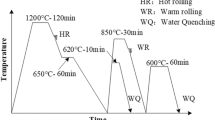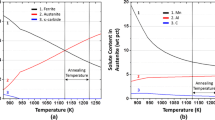Abstract
The automotive industry faces the challenge of enhancing fuel efficiency while meeting global environmental regulations concerning emissions. Thus, advanced high-strength steels (AHSS) recently gained significant attention due to their improved combination of strength and ductility compared to conventional steels, allowing the manufacturing of lighter body-in-white assemblies. Among the AHSS, medium-manganese steels, which contain 3–12 wt% Mn and belong to the third-generation category, are of great interest. Since the mechanical and microstructural properties of medium-manganese steels rely heavily on the amount and stability of retained austenite, the impact of adding vanadium, ranging from 0 to 0.75 wt%, was explored. The results showed that the microstructure of the microalloyed medium-Mn steels consists of martensite and retained austenite phases. The findings also revealed that increasing the vanadium content led to an increase in the proportion of retained austenite coupled with the refinement of austenite grain size.
Access provided by Autonomous University of Puebla. Download conference paper PDF
Similar content being viewed by others
Keywords
Introduction
Advanced high-strength steels (AHSS), which offer better strength-to-ductility combinations in comparison to conventional high-strength steels (HSS), have attracted significant attention in the automotive industry [1, 2]. These steels offer a combination of economy, reduced densities, and recyclability. The automotive industry is a huge consumer of the AHSS. The advanced high-strength steels are classified into three main categories, first generation, second generation, and third-generation AHSS. The third-generation AHSS includes medium manganese steels, which is the scope of the present work [3, 4].
The concept of medium manganese steels, containing 3–12 wt% Mn, was originally started by Miller in the 1970s. In addition to manganese, the common alloying elements in medium manganese steels are carbon (0.01–0.7 wt%), aluminum (0–10 wt%), and silicon (0–3 wt%). Manganese plays a role in austenite retention and stabilization at room temperature. The addition of manganese results in a decrease in the martensite start (Ms) temperature and lowers the Md30 temperature. The addition of manganese also decreases the Ae1 and Ae3 temperatures. Consequently, this lowers the austenite ferrite intercritical temperature range. Like manganese, carbon also acts as an austenite stabilizer and lowers the Ae1 and Ae3 temperatures. Carbon also plays a role in solid solution strengthening for the ferrite and martensite phases. Increasing the carbon content increases the austenite stacking fault energy, thus impacting the deformation behavior of the austenite. Aluminum acts as a ferrite stabilizer and increases the size of the ferrite–austenite region. It also reduces the density of the steel, which is important in reducing its overall weight. The addition of aluminum also increases the stacking fault energy of austenite. Silicon has a similar effect to that of aluminum in ferrite stabilization and reduction of the mass density of the steels. Finally, silicon is also important for solid solution strengthening of the steels [3].
More recently, attention has been given to medium manganese steels due to the higher demand for high-strength and lightweight steels from the automotive industry. Tensile strengths of up to 2400 MPa and total elongation of up to 95% have been reported for medium manganese steels. The mechanical behavior of medium manganese steels is highly dependent on the volume fraction and stability of retained austenite, which improves the work hardening rate and provides better strength-ductility combinations. The most common strengthening mechanisms within this group of steels are transformation-induced plasticity (TRIP) and twinning-induced plasticity (TWIP). These mechanisms depend on the stacking fault energy (SFE), which is a composition-dependent parameter. In general, an austenite stacking fault energy of <20 mJ/m2 promotes TRIP, and an SFE >20 mJ/m2 results in the formation of mechanical twins (TWIP). When the SFE is in the range of 16–20 mJ/m2, TWIP and TRIP can occur simultaneously. However, the occurrence of these mechanisms does not solely depend on austenite, but may also be influenced by carbon content, stress, and grain size. Other strengthening mechanisms, such as solid solution strengthening and precipitation strengthening, also contribute to the mechanical properties of these steels[1, 3,4,5].
The microalloying of medium manganese steels using niobium, titanium, vanadium, and molybdenum has been found to enhance their mechanical properties. The microalloying elements precipitate in austenite and ferrite as fine carbides, nitrides or carbonitrides, and contribute to grain refinement and precipitation strengthening. The addition of 0.15 wt% Ti to 5 wt% in Mn-steels has been found to suppress grain growth in the austenite phase [6,7,8]. Adding 0.22 wt%Mo, 0.05% Nb, and 6.5% Mn increases the stability and volume fraction of retained austenite at room temperature; thus improving mechanical properties such as ductility and yield strength [9]. The addition of vanadium has been reported to produce vanadium carbide precipitates, which increase the yield strength of ferrite by precipitation hardening without compromising ductility [10,11,12,13]. Since the effect of the incremental addition of vanadium has not been extensively studied yet, in this work, the effect of microalloying medium manganese steel is investigated. Three steels with different vanadium contents, 0, 0.06, 0.75 wt%, were studied and characterized.
Materials and Methods
The medium manganese steels with different vanadium content were cast using an arc melting furnace. Their chemical composition compositions were obtained by means of Inductively Coupled Plasma (ICP) and are presented in Table 1. These samples were prepared by rough polishing using sandpaper from 240 to 1200 grit, followed by fine polishing using 3- and 1-micron diamond suspension. To perform microscopy analysis, the polished samples were etched using 4% nital solution. The microstructural analysis was carried out using a Zeta-20 optical microscope and a JSM-6010LA analytical scanning electron microscope equipped with EDS detector. The samples were also analyzed using electron backscatter diffraction (EBSD) to evaluate microtexture and crystallographic information using a Hitachi SU-70 electron microscope. The data was then analyzed using HKL Channel 5 software.
Results and Discussion
The optical microscopy images of the medium manganese steels with 0, 0.06, and 0.75 wt% vanadium are shown in Fig. 1. The dark (martensite) and light (austenite) regions denote the formation of a dual-phase structure. It appears that the addition of vanadium increases the retained austenite during cooling, consistent with the effect of an austenite stabilizer. The observed retained austenite seems to be from the grain boundaries of prior austenite grains. On the other hand, the formation of the martensite matrix is due to the rapid quenching and high hardenability due to the relatively high manganese content of the steels. The observations from the optical images are consistent with the scanning electron microscopy images, as shown in Fig. 2. A martensitic structure is evident, and the grain size decreases with the addition of vanadium.
In order to confirm the existence of retained austenite, an EBSD analysis was performed, as displayed in Fig. 3. In Fig. 3a–c, the distribution of austenite on the martensitic matrix is presented. As can be observed, the retained austenite fraction increases with increasing vanadium content. More specifically, the retained austenite increased from 6.9 wt% (0 wt% V) to 14.5% (0.06 wt% V). However, only a slight increase in retained austenite is observed from 0.06 wt% V (14.5 wt% austenite) to 0.75 wt% V (14.8 wt%). The crystallographic texture appears random, as can be seen from the Inverse Pole Figure maps in Fig. 3d–f.
The incremental change of austenite fraction due to the addition of vanadium is presented in Fig. 4a, complemented with microhardness measurement in Fig. 4b. The retained austenite increased the strength of the medium manganese steel, which can be accounted to the TRIP effect during deformation. A more detailed analysis related to the formation of retained austenite on microalloyed medium manganese steel will be studied in future work. Moreover, the effect of heat treatment on the phase stability of retained austenite will also be explored.
Conclusions
This work explored the effect of vanadium addition on medium manganese steels. It can be concluded that the volume fraction of retained austenite increases with the addition of vanadium, as can be seen from optical and electron microscopy images. The retained austenite appears to be situated along the boundaries of the prior austenite grains during solidification. The addition of vanadium also increased the hardness of the medium manganese steels by about 5%. This can be attributed to the TRIP effect from the retained austenite generated by adding microalloying elements. Future work is needed to understand the mechanism of the formation of retained austenite after vanadium addition, including the response of the material after heat treatment.
References
Lee Y-K, Han J (2015) Current opinion in medium manganese steel. Mater Sci Technol 31(7):843–856. https://doi.org/10.1179/1743284714Y.0000000722
Hu B, Luo H, Yang F, Dong H (2017) Recent progress in medium-Mn steels made with new designing strategies, a review. J Mater Sci Technol 33(12):1457–1464. https://doi.org/10.1016/j.jmst.2017.06.017
Sun, B et al (2023) Physical metallurgy of medium-Mn advanced high-strength steels. Int Mater Rev:1–39. https://doi.org/10.1080/09506608.2022.2153220
Sun B, Processing, microstructure and mechanical behavior of medium manganese steels
Dumay A, Chateau J-P, Allain S, Migot S, Bouaziz O (2008) Influence of addition elements on the stacking-fault energy and mechanical properties of an austenitic Fe–Mn–C steel. Mater Sci Eng A 483–484:184–187. https://doi.org/10.1016/j.msea.2006.12.170
Wang Z et al (2016) Effect of molybdenum addition on the precipitation of carbides in the austenite matrix of titanium micro-alloyed steels. J Mater Sci 51(10):4996–5007. https://doi.org/10.1007/s10853-016-9804-z
Han Y, Shi J, Xu L, Cao WQ, Dong H (2011) TiC precipitation induced effect on microstructure and mechanical properties in low carbon medium manganese steel. Mater Sci Eng A 530:643–651. https://doi.org/10.1016/j.msea.2011.10.037
Han Y, Shi J, Xu L, Cao WQ, Dong H (2012) Effects of Ti addition and reheating quenching on grain refinement and mechanical properties in low carbon medium manganese martensitic steel. Mater Des 34:427–434. https://doi.org/10.1016/j.matdes.2011.08.015
Varanasi RS, Gault B, Ponge D (2022) Effect of Nb micro-alloying on austenite nucleation and growth in a medium manganese steel during intercritical annealing. Acta Mater 229:117786. https://doi.org/10.1016/j.actamat.2022.117786
Pham MK, Nguyen DN, Hoang AT (2018) Influence of vanadium content on the microstructure and mechanical properties of high-manganese steel. 18(2)
Di X, Li M, Yang Z, Wang B, Guo X (2016) Microstructural evolution, coarsening behavior of vanadium carbide and mechanical properties in the simulated heat-affected zone of modified medium manganese steel. Mater Des 96:232–240. https://doi.org/10.1016/j.matdes.2016.02.038
Park TM, Jeong MS, Jung C, Choi WS, Choi P-P, Han J (2021) Improved strength of a medium-Mn steel by V addition without sacrificing ductility. Mater Sci Eng A 802:140681. https://doi.org/10.1016/j.msea.2020.140681
Lagneborg R, Siwecki T, Zajac S, Hutchinson B (1999) The role of vanadium in microalloyed steel. Scand J Metal 28:186–241
Acknowledgements
The authors acknowledge with gratitude funding received from the Natural Sciences and Engineering Research Council of Canada (NSERC), Canada Foundation for Innovation (CFI), New Brunswick Innovation Foundation (NBIF), and the Harrison McCain Foundation.
Author information
Authors and Affiliations
Corresponding author
Editor information
Editors and Affiliations
Rights and permissions
Copyright information
© 2024 The Minerals, Metals & Materials Society
About this paper
Cite this paper
Zvavamwe, F., Paek, M., Nyamuchiwa, K., Aranas, C. (2024). Effect of Vanadium on the Mechanical and Microstructural Properties of Medium-Mn Steels. In: TMS 2024 153rd Annual Meeting & Exhibition Supplemental Proceedings. TMS 2024. The Minerals, Metals & Materials Series. Springer, Cham. https://doi.org/10.1007/978-3-031-50349-8_121
Download citation
DOI: https://doi.org/10.1007/978-3-031-50349-8_121
Published:
Publisher Name: Springer, Cham
Print ISBN: 978-3-031-50348-1
Online ISBN: 978-3-031-50349-8
eBook Packages: Chemistry and Materials ScienceChemistry and Material Science (R0)








